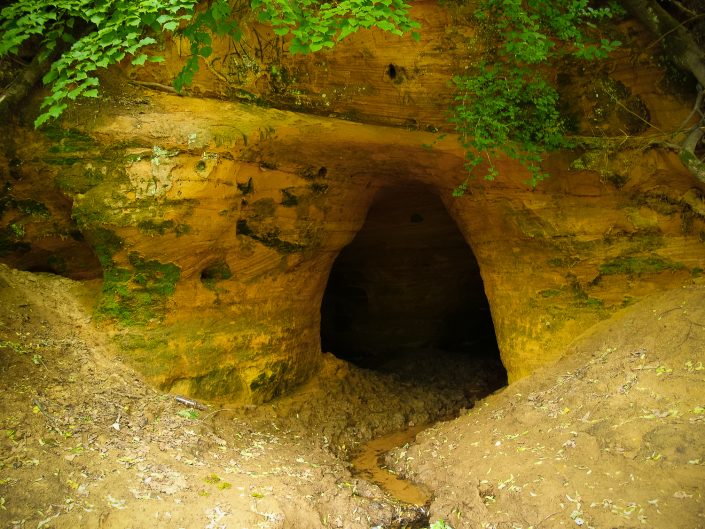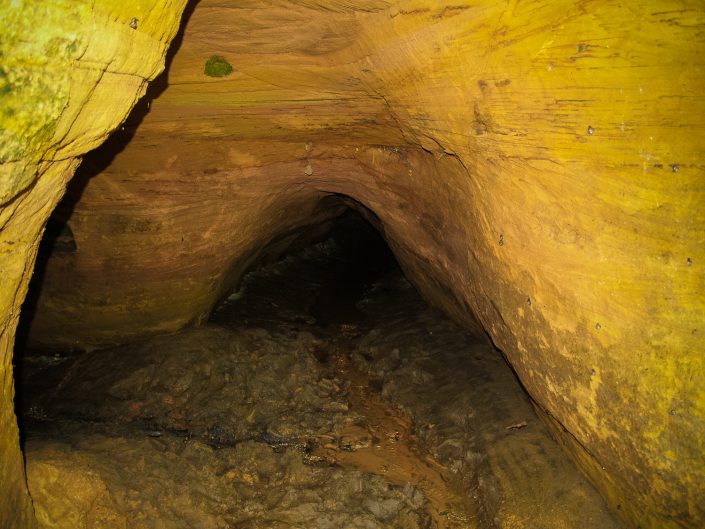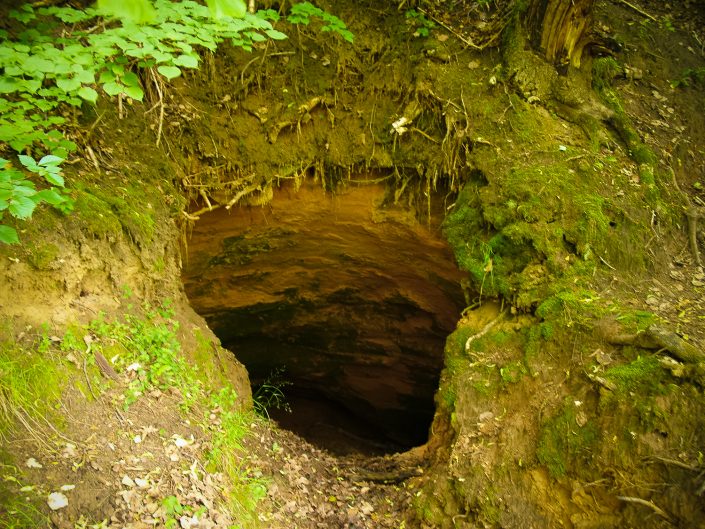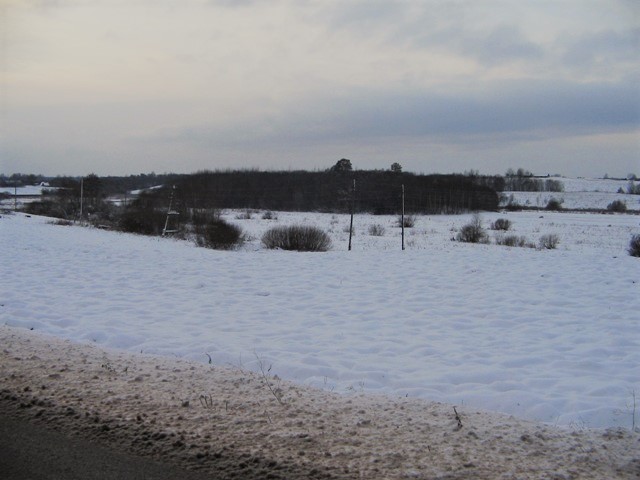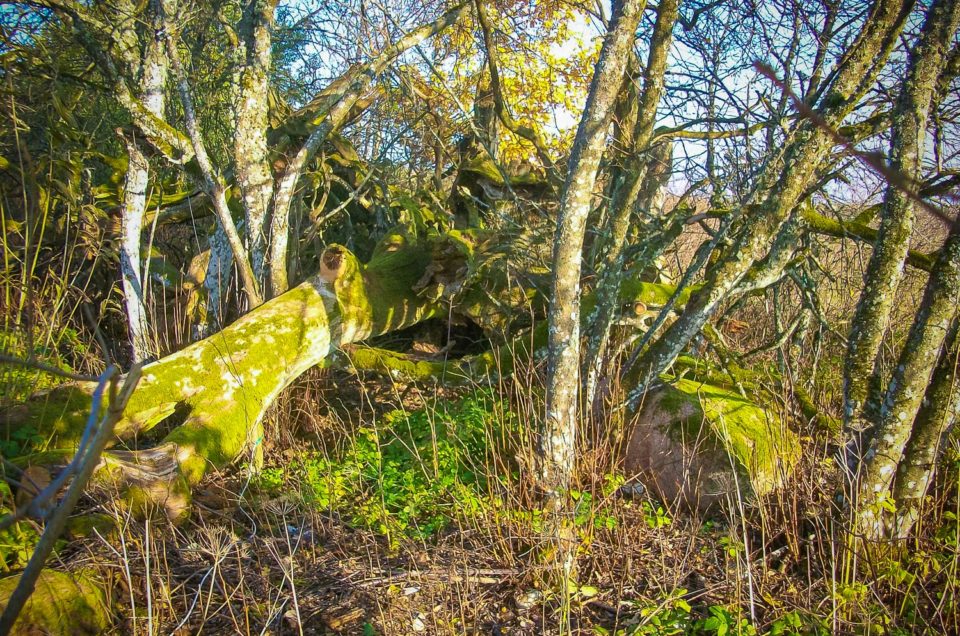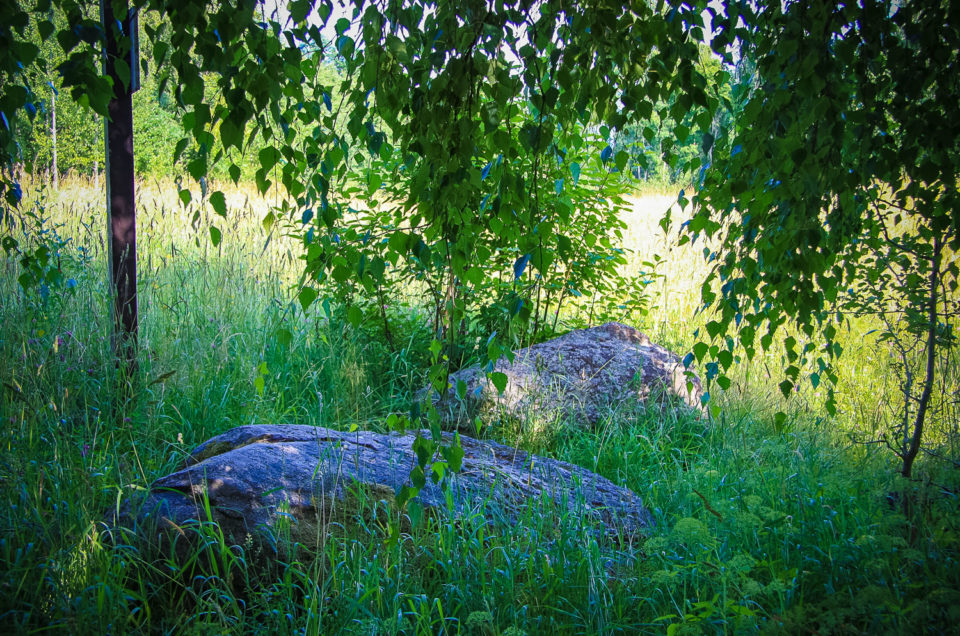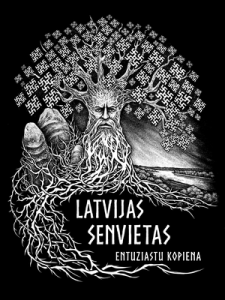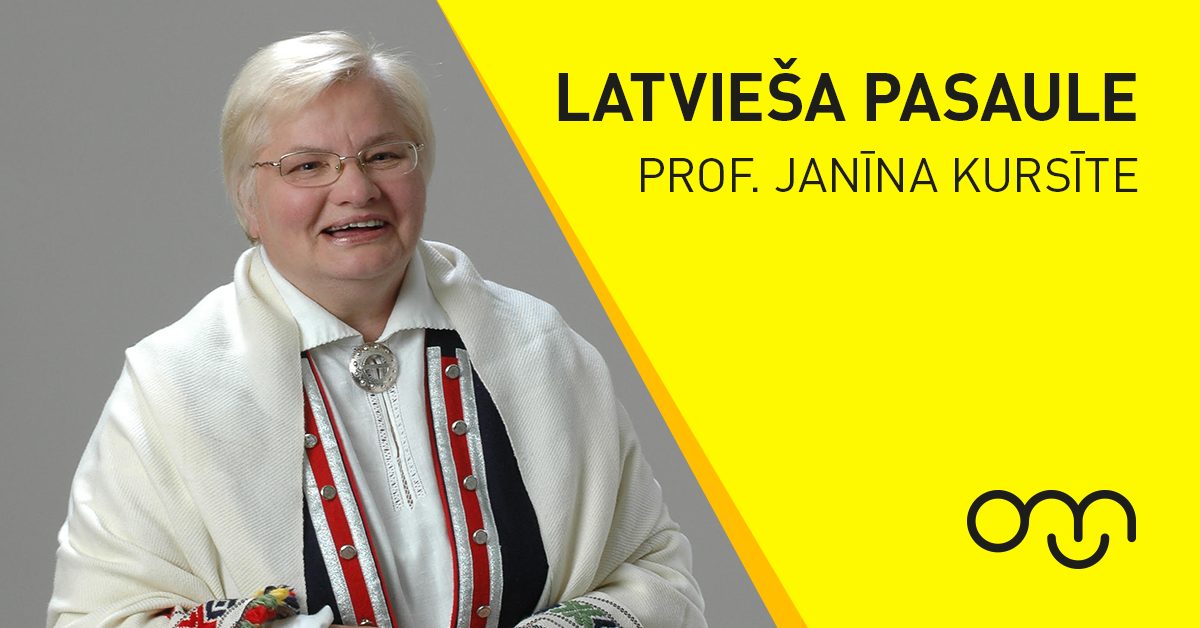On the 12 m high steep bank of the Salaca River, in the bight of Vīksnas, there are occasional sandstone exposures. In the largest sandstone exposure, there is an oval cave mouth, which in summer time, during the little water period of the Salaca river, is located only a few centimeters above the level of the river, but during the high water period, it is partially flooded with water. The Vīksnu Devil’s Cave is a suffosive cave, which is still being formed by two springs, joining into one brooklet just before their breakout into the sunshine. The springs have gnawn at the sandstone several cave paths. The longest of them leads into a 24 m deep underground. At the entrance into the cave, the height of the ceiling is 2.1 m, which is gradually decreasing, reaching only 70 centimeters at the fifteenth meter. The last 10 m in the cave can be accomplished only by taking a crawling position. The other path washed away by the spring is 8 m long, which in turn is joined from the left side by one more 4 m long dry path without any spring, which apparently is a filled up other entrance into the cave. The total leangth of the cave is 36 m, but the ground square – 41 m2 (Eniņš, 1990). Having received news that a new cave had appeared on the banks of the Salaca river downwards Staicele, in 1989 Guntis Eniņš visited it and made measurements. At the same time he gathered information from a Staicele’s teacher that some 35 years before, i.e. in the mid 50’s of the 20th century, there was no cave at all, thus making a conclusion that if not the cave itself, which could have been formed inside the cliff already earlier, then its entrance had opened only during the recent years. The dull looking cave ceiling testifies about the earlier origin of the entrance to the cave. G. Eniņš described the new discovery in his publication „A New Cave on the Bank of the Salace River” in 1990, proposing to call the cave after the name of the nearby homestead – the Vīksnu Cave. This name has already adhered to the cave. If the entrance to the cave had opened only at the end of 80’s of the 20th century, it would not have been called the way the local people call it. However, in 2001, during an expedition, a local inhabitant Herberts Timermanis (born in 1934), who was met at the Vīksnu cave, revealed that the entrance to the cave had not opened only at the end of the 80’s; it had been known already earlier; it just got filled up in the course of time. During the Awakening time, H. Timermanis cleared up the entrance, so it became visible again; this is why G. Eniņš received news about appearance of a new cave on the banks of the Salaca river right about that time. A local history researcher J. Megris asserted that the cave had been visible already during the 30’s of the 20th century; thus it is possible that one can attribute the news published in 1930-ies to these caves, namely, that between the Staicele Plant and the estate of Rozēni (about 11 km), there are flourishing river banks and rocks with springs and caves occasionally (Melnalksnis 1930: 78). Nowadays there are no other caves known in that part of the Salaca River. According to H. Timermans’ narration, the cave had also a name – it was called after the nearby homestead Zvejnieku Velnala (the Fishermen’s Devil’s Cave) or simply – Velnala (Devil’s Cave). There were no tales about the cave found neither in publications, nor in the archive. Similarly Herberts Timermanis knew no particular tales about the Devil’s Cave; he only added that in older times children had been told not to crawl into the cave, because the Devil had lived there. Thus the Vīksnu Devil’s Cave is a part of the wide range of Devil’s caves considered to be Devil’s home. In 1999, a few meters from the Vīksnu Cave, upwards the steep bank of the old dale of the Salaca river, the employees of the North Vidzeme Biosphere Reserve dug up a filled up cave. The dug-up track has preserved until nowadays as a trench of 1 x 1 m. It turned out that this cave has also been known, and it also had a name – Āpšu ala (the Badger’s Cave). The name originates from an occasion when some master’s dog earthed a badger into this cave. Around 1980, Herberts Timermanis found five coins of the war time at the entrance of the Badger Cave. Although there are no tales in the local oral tradition about offerings in older times, one cannot exclude a possibility that the coins had been left in the cave as offerings. The Vīksnu Devil’s Cave and the nearby Badger’s Cave are both located in the North Vidzeme area, where, according to archeological and folklore evidence, the tradition of offerings in the caves lasted yet until the 19th century. Several of these caves had been called as Devil’s caves.Thus the Vīksnu Devil’s Cave, taking into account certain precaution, can be added both to mythological and cult caves. According to: S. Laime. Holy Underground. Folklore of Latvian Caves. Zinātne, 2009. p. 247-250.
“The cave had no special name at all; all locals called it the Fishermen’s Devil’s Cave after the Fishermen’s homestead located the closest to the cave. That cave was there already during my childhood years. The bigger kids frightened us that they would throw us to the Devil right into the cave. My father and mother also said: “Don’t crawl inside it, the Devil lives there!” The fishermen also used to say: “Well, where did you get the catch?” — “Under the Devil’s Cave.” The cave was filled up for a long time, I began to clean it up when Latvia started awakening. Now I clean it up every year for people to look at it. The cave above the Devil’s Cave was called the Badger’s Cave. Some master’s dog earthed a badger into it. According to the god’s barking one could guess that the cave was about fifty meters deep. The badger scraped out some coins of the Czar’s time from the cave. About twenty years ago, I found five coins of five kopeck there, the oldest one was dated as of the year 1874. I looked at them — such greenish small discs. I started looking for more, but found no more.” (Herberts Timermanis in Jāņjuri of the Staicele parish, born 1934; recorded by Sandis Laime 2001)
If the land proprietor, whose property one has to cross to reach the cave from the highway side, changes his mind, the object could have auto tourism potential, because until now the object was better known only by water tourists. A few years ago, the Staicele parish wanted to place an informative sign at the cave, to facilitate the site, but the Vīksnas homestead’s proprietor objected to that. They say he has changed his mind now.
